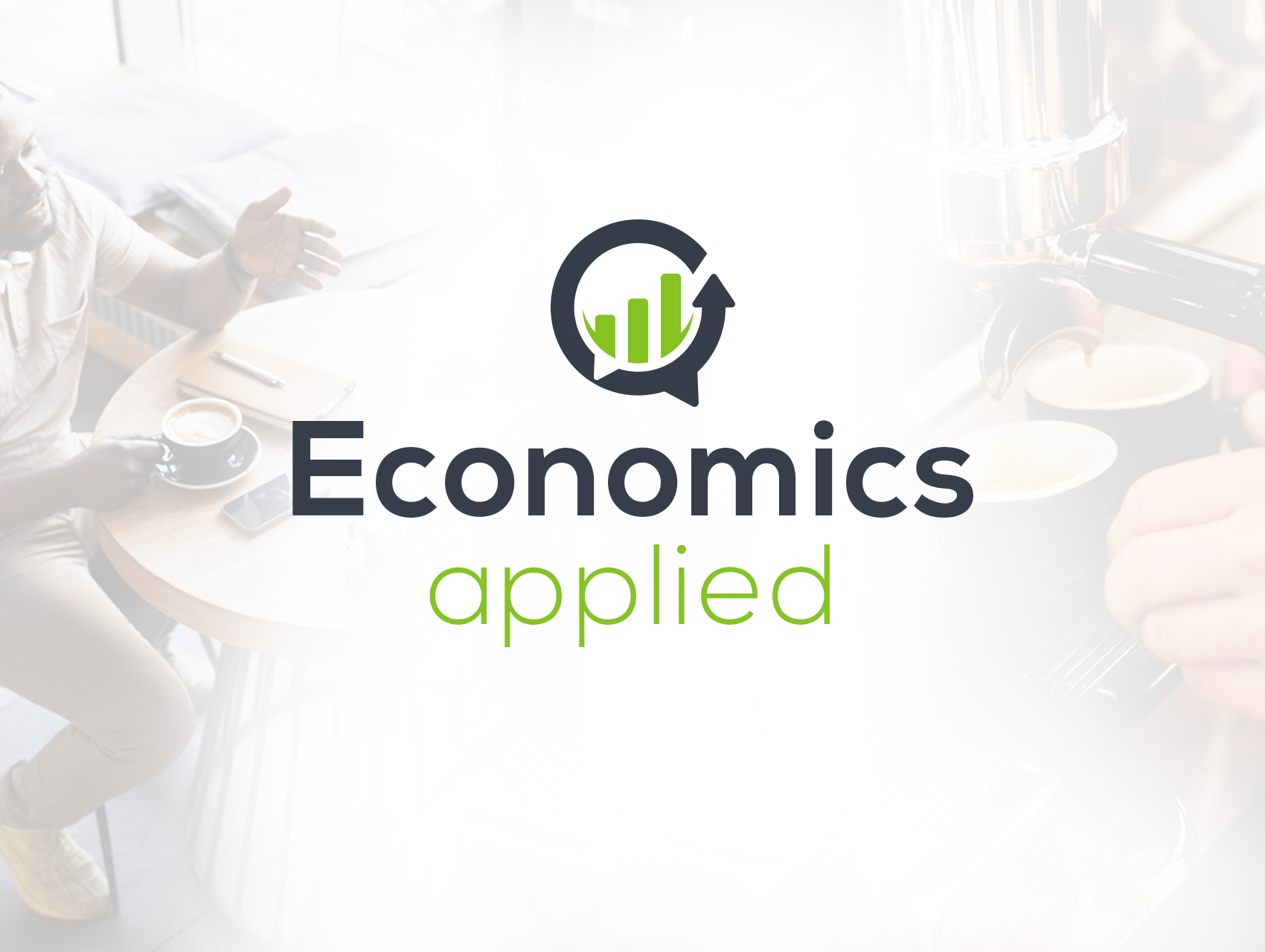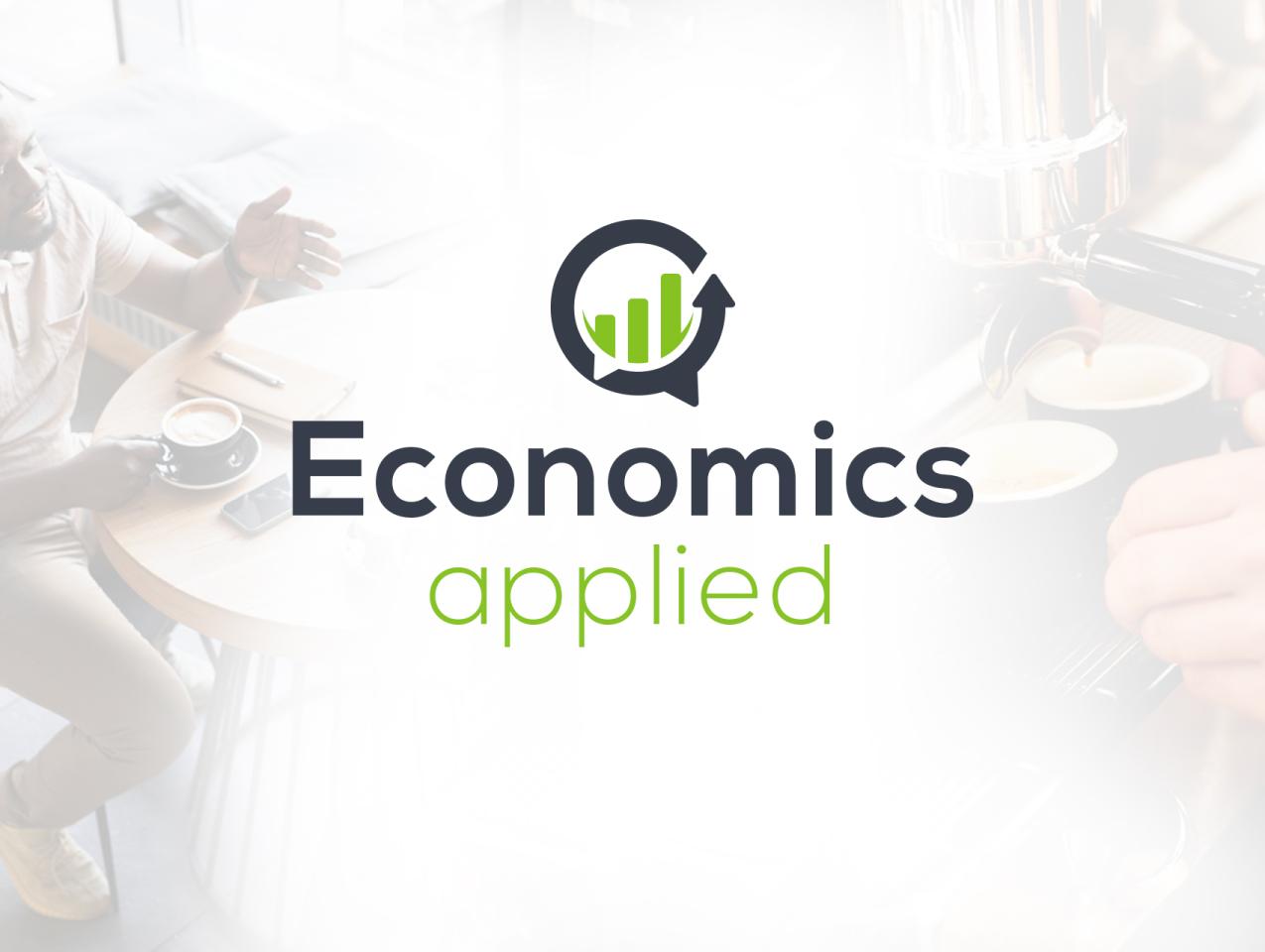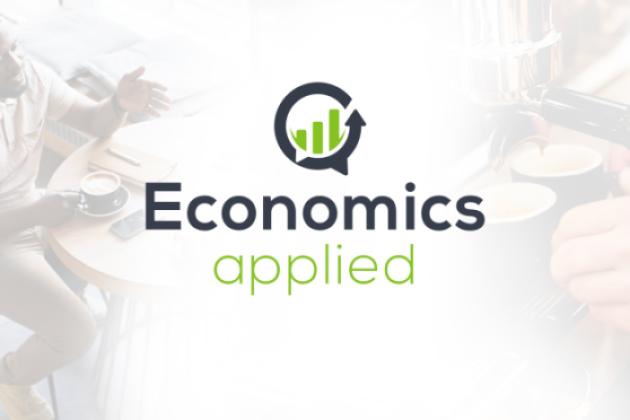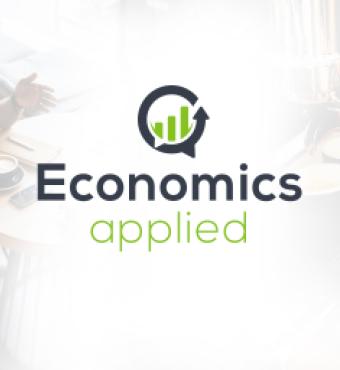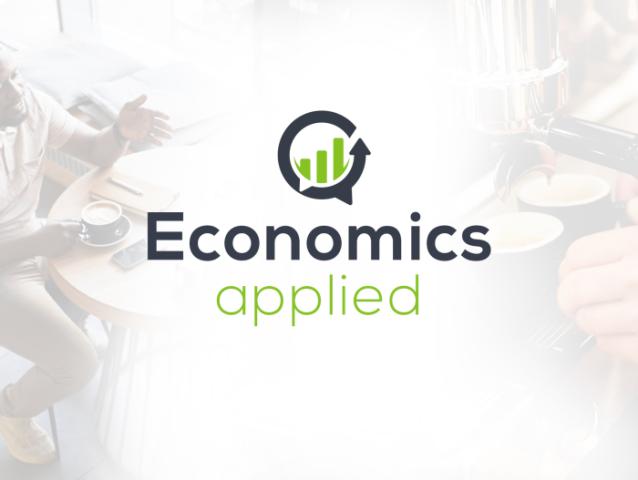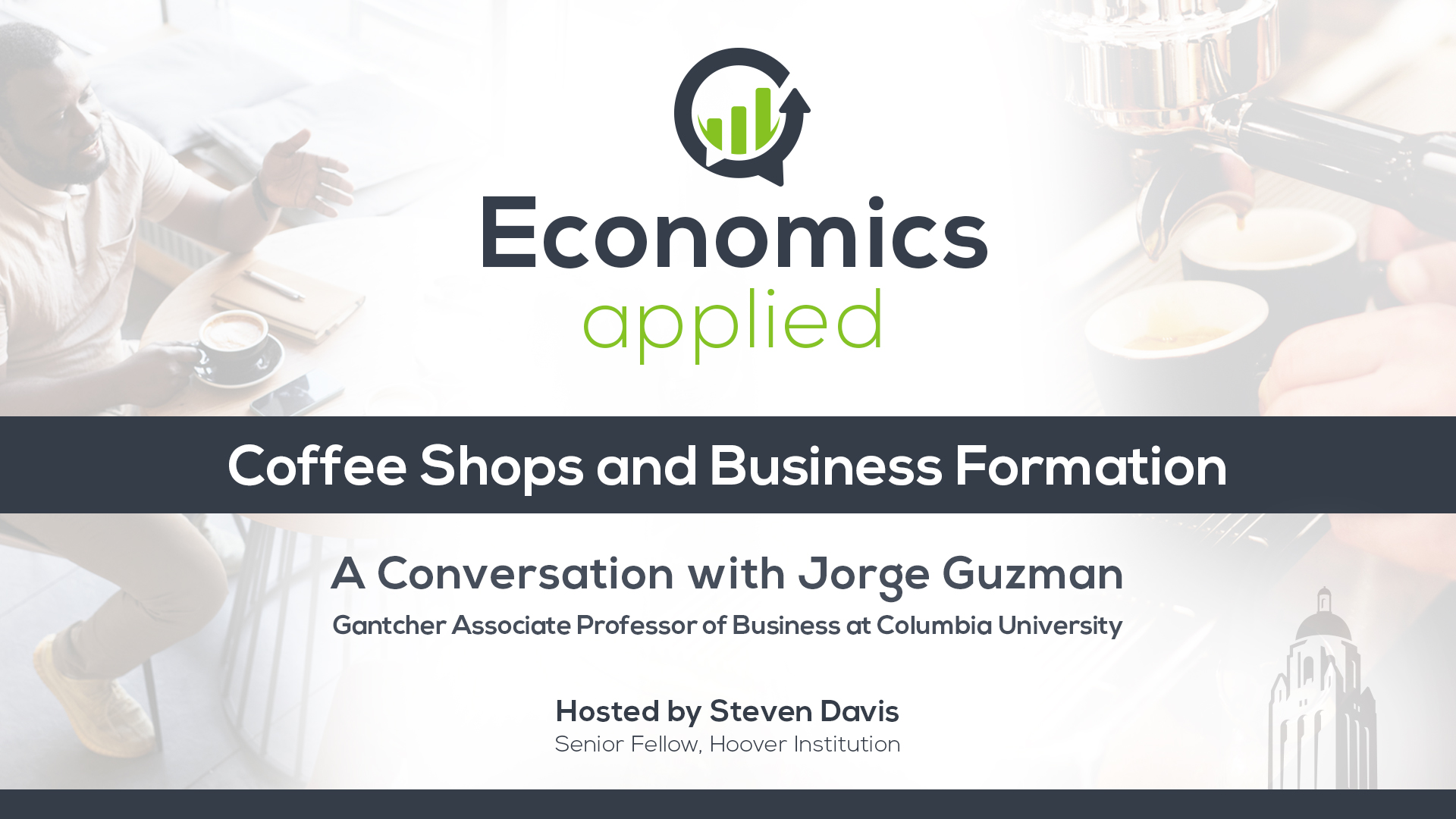Steven Davis interviews Professor Jorge Guzman about the effects of coffee shops on business startups. Starbucks and other sit-down coffee shops offer social spaces where people can converse, exchange ideas, and build trust. In his recent research, Guzman investigates whether and when this networking aspect of coffee shops leads to more business formation in the local neighborhood. Tune in for an assessment of his evidence and discussion of its implications for urban planning and how to strengthen local communities.
Steven Davis:
Coffee shops are places to meet and chat, and to get your jolt of caffeine. Aah. Our guest today has evidence that the social aspect of coffee shops can foster the creation of new businesses in the local community. We will consider his evidence in today's episode of Economics, Applied.
Welcome. My name is Steven Davis, I'm a senior fellow at the Hoover Institution and host of the show. Our guest today is Jorge Guzman, he is the Gantcher Associate Professor of Business at Columbia University. He's written several papers on entrepreneurship, and the factors that influence business formation. He's also served as an advisor to numerous startups, and to government agencies on how to foster entrepreneurship. Welcome, Jorge. It's great to have you on the show.
Jorge Guzman:
Thank you for having me here, Steve.
Steven Davis:
All right, it's our pleasure. You co-authored a recent study titled Third Places and Neighborhood Entrepreneurship: Evidence From Startups. We will get into-
Jorge Guzman:
From Starbucks.
Steven Davis:
From Startups, right. We will get into your approach and your evidence, but first, just sketch for us the conceptual argument for how coffee shops could, under some conditions, foster the creation of new businesses in the local neighborhood.
Jorge Guzman:
Absolutely. And again, excited to be here. The idea is straightforward if you take it from first principles. First, people benefit from meeting in-person, that is well-known in research labs, that is well-known in conferences for academics and all sorts of things, and so benefit in-person is useful. Second, space to meet actually matters, and there's research on water cooler [inaudible 00:02:06], and research on other things. There's a lot of work showing that a space to meet actually creates more social capital, what you might call it, in other aspects, in people needing help, in people kind of, when they're struggling with problems, when they need support. What was perhaps mentioned in different places, but never studied, was if something like that could actually improve something in the neighborhood that is a little bit more economic, like people getting through enough of the barriers that a few of them actually are able to start a firm that potentially they had in their mind, but hadn't been able to do so.
So that's the idea, by having a little bit of a bigger network, a little bit of friends, a little bit of people you can rely on, a little bit of a space to meet, some people are able to start businesses. It reminded me of AnnaLee Saxenian in her classic study of Silicon Valley, where she mentioned the wagon wheel was the bar. It was the core meeting spot for that community, and it really made a difference in terms of being able to connect and get businesses launch in a different setting.
Steven Davis:
Okay. So I take from that that it's not just any coffee shops. Drive-through coffee shops isn't really offering a place to meet. It's something about a suitable place to meet, presumably it's probably not on the street corner either, unless it is pleasant weather in the local environment. So I gather we'll be looking at coffee shops that meet certain conditions that make them congenial places to meet and converse. Is that right?
Jorge Guzman:
The reason we look at Starbucks, there's nothing that we think is too specific about the brand itself, but rather Starbucks is the sort of pioneer of this concept of a coffee shop that's a lot more, kind of hangout place than a coffee-buying place in the United States. The famous story that Howard Schultz takes a trip to Italy to think about coffee, and is sitting in Milan and realizes that the Italian coffee shops are quite nice. They sell coffee that is quite a bit more expensive, and maybe more complex, but they make up for it by having an appealing place to be, and just a place to hang out and sit with your friends, and he brings that concept back.
In the time period we study, they are the first ones introducing this concept, and they sort of anchor it, and this is why we have our title on this idea of third places. It comes from a sociologist called Ray Oldenburg, who was at his time really focused more on civic organization, but he says, "Look, people, these places to meet really matter." Just like taverns during the American Revolution, they really matter to bring people together and kind of get this civic action, and Starbucks copies that, takes that idea and says ... If you look at Starbucks 10-Ks in 2004, they say they're selling a third place experience. That's how they sell it. So we're sort of taking that concept from sociology, which is meeting places really matter to bring people together, and we're putting it more of an economic outcome, which is starting a firm.
Steven Davis:
Okay. So Starbucks pioneered this concept in the United States, and remains, I think, the largest implementer of this style of coffee shops, but they're not the only one. I guess back in, I'm near San Francisco, back in the Gold Rush Days of San Francisco, the local equivalent would've been the saloon.
Jorge Guzman:
Yes.
Steven Davis:
The point here is that saloons in their day, and Starbucks type coffee shops today, they're kind of open environments to all comers, which kind of distinguishes them, say from a church, which also plays some of this-
Jorge Guzman:
Or a country club. Exactly.
Steven Davis:
Or a country club. And they provide a venue that seems conducive to conversation, at least as long as the music's not too loud in the background in my experience, which sometimes it is.
Jorge Guzman:
It can be, yes.
Steven Davis:
So that's the concept, and that's the kind of motivation for your study. But then it's tricky to figure out among all the other things that are happening that are associated with the entry of a coffee shop or the presence of a coffee shop, to really isolate the impact of a coffee shop on the outcome of interest here, which is business formation in the local neighborhood. So tell us how it is you went about empirically assessing, and trying to tease out an independent effect for Starbucks-like coffee shops.
Jorge Guzman:
Right. That's absolutely right. So first, everything you mentioned is true, and there's evidence by my colleague Mike Andrews, that after prohibition, locations that had saloons, where the social structure were based around saloons, innovation dropped there. So it's kind of pretty consistent with what you're saying.
Steven Davis:
Okay. So prohibition leads to recession.
Jorge Guzman:
Well, if the social structure was based around saloons that would be-
Steven Davis:
Understood. Understood.
Jorge Guzman:
Similarly, what you're saying needs some regularity, open environment, et cetera. You're right, the obvious thing is Starbucks, and we're always thinking about this random assignment problem for inference, and Starbucks is not choosing its locations at random, for sure. So the question is, how can you compare the neighborhood that got the Starbucks to one that would be a good alternative, as if, and kind of tell you the path of this neighborhood if it hadn't gotten it? We followed three approaches. One of them is that-
Steven Davis:
You've got three different empirical approaches, I take it.
Jorge Guzman:
That's correct, three different empirical approaches. In the first one, or the one that we have a little bit more prominent in the paper, we focused on locations that were also going to open a Starbucks. So Starbucks chose to open location, but it turns out that not all locations where Starbucks initially planned to open, ended up opening one. These are locations that, for example, got a architectural review board that said, "You couldn't build this Starbucks." There's a few that have community organization. We literally just looked news that said the expected Starbucks is not going to open anymore through LexisNexis. So that comparison gives us a little bit better confidence because we're looking at neighborhood Starbucks wanted, but the difference is where they're actually able to open.
Steven Davis:
No, but let me make sure I understand. So you have a ... First, tell us what you mean by a location. What's the definition of the neighborhood or the location?
Jorge Guzman:
Right. So we look specifically addresses, but eventually when we're talking about neighborhoods, we think about census tracts. Census tracts are nice because they are sort of about 4,000 people, they're meant to track neighborhoods, they are decided by city boards. For example, in Manhattan, Morningside Heights where Columbia is, is one census tract, Manhattanville, where it's just a little bit further down, it's a different census tract, and then when you cross the street to Harlem, it's also a different census tract.
Steven Davis:
So neighborhood here is something you could ... you could walk the expanse of a neighborhood as defined by most census tracts in several minutes.
Jorge Guzman:
Right, or travel it easily if it's a very, sort of ... if it's a-
Steven Davis:
More rural area.
Jorge Guzman:
If it's a very rural area.
Steven Davis:
Okay. Then, so as I understand it, you got lists from Starbucks or somebody else, of new entry of Starbucks coffee shops, the first one into a census tract, and then-
Jorge Guzman:
That's right.
Steven Davis:
Okay.
Jorge Guzman:
We focus specifically on census tracts that had no prior coffee shops.
Steven Davis:
Okay. Okay, good. So that's what I was trying to get at. So this is the first of this kind of venue, where open to all comers, have a nice cup of coffee, sit down and chat, pleasant music in the background, and you're looking at the first entry of these into census tracts. Then you have a list of those that actually did open as planned, and another list of those where Starbucks had intended to open a coffee shop, but for whatever reason did not.
Jorge Guzman:
That is correct.
Steven Davis:
Okay.
Jorge Guzman:
I'll foreshadow this, but eventually, deep into the paper, we do look at census tracts that have already coffee shops and that Starbucks joins. There, we find no effect, which is kind of consistent because it's really about what it brings into a neighborhood's ability to function rather than just Starbucks itself. But going back to these rejected, we call them rejected, rejected Starbucks, we can do two things. First, we can see what happens to the neighborhood if that Starbucks would've opened. You see what I mean? So we can see. Typically, we always evaluate pre trends, which is we see how the neighborhood is doing before the Starbucks come in, and we do that, and they look well in our paper, but we can also say, "Well, these ones that got rejected, what ended up happening?" So we can see that when Starbucks doesn't enter, there's actually no big pre trends either, and so we can then draw a comparison ... Yeah, go ahead.
Steven Davis:
Let me describe what I understand you to be doing.
Jorge Guzman:
Absolutely.
Steven Davis:
Basically, you got these two lists, Starbucks entered, Starbucks wanted to enter, but for whatever reason it didn't.
Jorge Guzman:
Right.
Steven Davis:
Then you're comparing the average outcome in terms of new businesses formed over the next couple of years or so in each location, and you're using statistical methods to control for other things that might distinguish these two neighborhoods. That's the statistical detail, but essentially setting that aside, you're just comparing average outcomes across these two lists.
Jorge Guzman:
Right, average increases.
Steven Davis:
Outcomes being new business formation.
Jorge Guzman:
Right, right, right. That's correct.
Steven Davis:
So that's the average. So tell us what basically do you find as the difference between neighborhoods that get the new Starbucks, and neighborhoods that were slated to get the new Starbucks but did not? What do you find there?
Jorge Guzman:
The neighborhoods that get the new Starbucks have more startups over the subsequent seven years on average, depending on exactly how you count them. We estimate between 3 and 11%, which is 3% amounts to one new startup, in startup we mean a business registers with the legal address in that neighborhood.
Steven Davis:
So does that mean they hire, the businesses you're picking up, do they hire employees or are they sole proprietors? What kind of businesses are they?
Jorge Guzman:
They're not sole proprietors. Sole proprietors is anybody that decides to file a 1099, if you do consulting for $500, you should file one, et cetera, so there's a vast magnitude of those. Employer businesses, including from your work, Steve, they're a much smaller share. This group is different. This group is registered business, so it's every corporation, limited liability company, and limited partnership. Basically, if you want to have a corporation, it's not enough for you to just decide to do so, there's a physical paperwork that you need to file in the state of California, or in the state of Delaware, or wherever it may be, and that filing itself, from a legal perspective, forms the birth of the business, if you see what I mean.
Steven Davis:
Okay, I get that. Now, you mentioned 3 to 11% the differential effect between you get the new Starbucks, you're slated to get it, but you didn't, but that's 3 or 11% over what time period?
Jorge Guzman:
On average over the next seven years.
Steven Davis:
So you get 3 to 11% more businesses every year for seven years or-
Jorge Guzman:
That's correct. That's correct.
Steven Davis:
Okay. So that seems like a sizable amount. This is a cumulative effect then as I understand it
Jorge Guzman:
Right. So the average tract has 20 businesses registered, and now you have 21, maybe 22 businesses registered each year.
Steven Davis:
Each year. But I'm still struggling to understand, does that mean seven years out I go from 20 to 22, or I go from 20 to 35 or something?
Jorge Guzman:
Oh, I see. Well, right, it doesn't compound the effect.
Steven Davis:
It doesn't compound. Okay.
Jorge Guzman:
That's right. So if the average tract registers 20 new firms per year, so it is a new kind of event per year, the average tract with the Starbucks is registering 21 or 22 new firms per year, but it doesn't compound to then [inaudible 00:15:34].
Steven Davis:
I got it. I got it. Okay. So it's a 3 to 11% increase not on the initial number of businesses, but on the new business formation numbers.
Jorge Guzman:
That's right, on the number per year, so we don't track the stock of businesses.
Steven Davis:
Okay, that's very helpful. Okay, and this is a, in a statistical sense this is a significant difference. You have enough data so it's not just something that is due to random chance.
Jorge Guzman:
That's right.
Steven Davis:
We can rule that out. As we discussed briefly before, you're trying to control for other factors that distinguish the neighborhoods that got the Starbucks, and the neighborhoods that were slated to get one, but didn't.
Jorge Guzman:
Yeah. We'll talk about our other statistical approaches later, but one thing that could be in your mind is it takes a certain neighborhood for it to end up rejecting a Starbucks, and so we do dig into that quite a bit, and understand whether that can drive that. You could be concerned that it's sort of a special control group in that sense.
Steven Davis:
Well, that is what I wanted to ask you about. So if there's a neighborhood that Starbucks wants to enter, and for some reason, including possibly resistance from people in the neighborhood-
Jorge Guzman:
That's correct.
Steven Davis:
Doesn't enter. Well, that strikes me as are you picking up the effect of neighborhoods that are just not very hospitable to new businesses or certain kinds of new business or are you picking up a Starbucks effect? It seems to me like this first method is conflating those two effects. Have I got it right?
Jorge Guzman:
Well, right, right, if you feel ... We could look into this. I think what you're saying is, you're saying, "Well, they're not as hospitable," and the characteristics of these neighborhoods are actually they have lower share of minorities, there's more urban, they have a slightly higher income, which would be consistent if you think about, for example, architectural review issues, it kind of has to be a pretty urban place usually. Now, they might be different, but remember what we're looking is the increase, and so the question is, are they on a certain kind of trajectory that biases is ripe? Are they on a different trend? In that case, we would worry that these are neighborhoods that are going down perhaps economically, and so we're protecting the local businesses.
Steven Davis:
No, but I don't ... Well, I see that these differential trends could be an issue, but the issue I'm concerned about is I think a different one.
Jorge Guzman:
I see.
Steven Davis:
Which is that the underlying openness to new business formations or at least a Starbucks type business, is different between the two neighborhoods. It doesn't make the result uninteresting, but there's two possible interpretations of this first set of results, and I want to get your reaction to this as I see there's two possible interpretations. One, you're picking up a coffee shop effect, that's interesting. The other one is you're picking up an effect of the receptivity of the local community to certain kinds of businesses, that's still an interesting effect, but the message is different. The message is then if you want to foster new business formation, be receptive to new business applications, and that's a different message.
Jorge Guzman:
Right, right, right. I agree it would be a different message, so I'll start there. The question is, is this friction? You are not receptive. Does it really, I mean, certainly along the path of these differences being whatever thing you compare it, it's typical with immigration, is it really the immigration or is it the fact that you're getting in the way between a company trying to hire an immigrant, that immigrant trying to come and you get in the way? Well, of course if you could take that away, then immigration is probably good. It's a similar thing here, where these things were along the pathway, but eventually we do feel we're kind of able to compare a world with the Starbucks and without.
I can tell you other ... I want to make sure to take each identification strategy together, but we have a different one called not yet treated, which means you compare this place that gets a Starbucks to another one that's going to get it later on. They both end up being receptive to Starbucks, both locations end up being appealing to the Starbucks, and the effects are kind of quite similar to this one.
Steven Davis:
Okay, let's walk through that one. So here you're using a different control group, so to speak.
Jorge Guzman:
That's right.
Steven Davis:
In the language of statistical analysis, rather than neighborhoods that were slated to get a Starbucks, but did not get a Starbucks. You're just looking at different neighborhoods that got a Starbucks, but later.
Jorge Guzman:
That's correct.
Steven Davis:
And now you're telling us that, as I understand it, the timing of when you see the uptick in business formation tracks the timing of the entry of, the actual entry of the Starbucks or in the wake of that entry. Is that correct?
Jorge Guzman:
That's right. So it's comparable, as you said. You could say, "Well, this neighborhood presumably was somewhat appealing to Starbucks." Neighborhoods don't change as quickly to completely change over three or four years, especially something like attitudes to corporations, and we see very similar effects.
Steven Davis:
Okay, same magnitude and so on.
Jorge Guzman:
So that one is more precise, and ends up being, I said 3 to 11%, because we can include a lot more tracts, it's everybody what we call treated. I'm almost sure it's a five to, kind of more seven rate, so it's a little bit narrow. It doesn't have to be the same because it's a little bit of a statistical comparison.
Steven Davis:
So this second one is interesting. I agree it's not subject to the concern I expressed about the first empirical design. It does raise a different issue.
Jorge Guzman:
Yup.
Steven Davis:
Well, I want to get your reaction to that, which is Starbucks is likely, more like the other thing than all else equal to enter for the first time into a neighborhood when that neighborhood is on the upswing. Maybe that neighborhood has a new little mall, and it's going to have six or seven shops, and one of them is a coffee shop. So Starbucks is entering at the time when, for a variety of other reasons, new business formation is up. So that's a different confounding factor than what we talked about in the first empirical design. Do you agree that's an issue in this second design?
Jorge Guzman:
Yes. I mean, it would be an issue if we hadn't done a battery of tests to understand to what extent that's happening. There's two ways, as you said, real estate agents sometimes call these the Starbucks effect, which they ... it's an amenity in a neighborhood. You can imagine it changing real estate prices. You can imagine other things like that. You can also imagine the Starbucks itself, it comes in and there's sort of what we call an economics demand pooling because you can go to Starbucks now, you go and buy your [inaudible 00:23:09]. Of course, in your mall example, that's a very good one because the stuff wouldn't happen before the entry of the Starbucks, but it's really the mall opening that opens all the businesses rather than the Starbucks itself. Right?
Steven Davis:
Right.
Jorge Guzman:
So let me tell you what evidence we have on this topic because I think it's a very important one. We have the basics first on these events studies that we mentioned. In the first, there is no pre trend, so that means that a neighborhood that's on the upswing should have seen increasing entrepreneurship even before Starbucks enters, of course conditional in the way we control for it. Second, according to our idea of social networks in third places, that doesn't happen over a day, that happens as people develop a little bit more social capital, and so we should see a more slower effect that takes a few years to really reach its new level, and that's kind of what we see.
But then we do a few other things, the first thing we do is we use SafeGraph data. SafeGraph is a really nice data that uses kind of geo-coded tracking, it tracks different people and how they're moving across locations, and they also have the footprint of each establishment based on satellite images, and we test for two things. We test whether Starbucks that are getting a lot of people are the ones that predict a bigger effect, and we also test the Starbucks that are bigger predict a bigger effect. In fact, usually the mall example, it is about very small Starbucks inside a big establishment, and we find no effect for those. We find a large effect on a larger footprint or a larger-
Steven Davis:
There's a lot to unpack there. I want to go back to something you said in the first part of your remark, and draw attention to it because I think it involves a different reason, a different mechanism through which coffee shops can facilitate business formation than the one you set forth at the beginning of our conversation. One, you set forth at the beginning of our conversation was about coffee shops as meeting places that facilitate the exchange of ideas, getting to know someone, and that could foster business formation.
But now you made a different point, which is a coffee shop has amenities value to people in the local neighborhood, and just makes more people want to come into that neighborhood, possibly from other neighborhoods nearby, or possibly just come out of their apartments and go to the coffee shop. But that makes it a more attractive place not because of networking reasons just because you've got more foot traffic on the street and so on, for other types of businesses, maybe a bakery, something else, or maybe a-
Jorge Guzman:
That compliments coffee.
Steven Davis:
Hair salon. Right. So that's another way in which coffee shops could facilitate business formation, but it's not working through the social networking effect.
Jorge Guzman:
That's right.
Steven Davis:
Do I understand correctly that you intend to capture both the amenity value effect and what it does to local foot traffic, as well as the social networking aspect? Are you trying to separate those out?
Jorge Guzman:
Right. I think what I've said so far, maybe if you're a reader you might think, if you're a sympathetic reader you'd say, "Okay, I'm convinced Starbucks comes into a neighborhood and the neighborhood sees more companies." Now you're sort of telling me, "Well, why is that? Is it really networks? Is it what we in economics call demand pooling?" Which is the same thing you call foot traffic. It's just cheaper for me to sell phones right next to a Starbucks because people are coming to Starbucks anyways, for example.
Steven Davis:
Right. Right.
Jorge Guzman:
We do probe at that, and it's one case where I would've been happy if any answer would've been true, but to do that what we do is we do two, well, three things. First, we separate the types of companies that are getting registered, and we look at real estate companies. Let me take the gentrification story first, that's not the demand pooling, but rather this is just a neighborhood on the upswing, then you would see maybe an even more substantial increase on real estate startups. We actually see zero effect on real estate, real estate companies and realty, realtors and things like that, and that is sort of less consistent with the-
Steven Davis:
Yeah, although they don't draw that much foot traffic in [inaudible 00:27:50].
Jorge Guzman:
Right. Then second, right, on the foot traffic side you might feel like what are the natural compliments here? Well, you look at the retail sector, NAICS sector is 44 and 45, and you would look at the food sector, NAICS sector 72, those are the most obvious compliments. What we would expect if this was a story, was to see a ... If I tell you it's 5%, 6%, 4%, you see a bit of a larger effect on these sectors, that would tell me, "Oh, if Starbucks is increasing food registrations by 20%, then it seems like it's the complimentary," but we don't see that, we see the effect. We do see more food entrepreneurs, more food registrations, and more retail registrations, but also at the 4, 5% that I was mentioning.
Steven Davis:
Let me make sure I understand that. I understand you're making the following argument. You agree that in principle there's both these foot traffic, amenity value effects as I described them, and also the social networking effect. When you look in detail at the kinds of businesses that tend to be stimulated or fostered in the wake of a Starbucks entry, it suggests to you that at least a substantial part of the story really does involve the social networking, and it's not just about the demand pooling as you called it, or the foot traffic effect as I called it.
Jorge Guzman:
Right, right. I think I probably dropped the evidence in a little bit different groups, but in terms of the foot traffic, that's where we separate amongst different groups, and that was foot traffic and gentrification. So that helps us what you might say rule out, to some extent, that it is really that driving it, and on the other hand, to what you might call rule in sort of social networks. We see that larger Starbucks have a larger effect. We also see that the benefit is only when there's no other coffee shops in the neighborhood, so it's really sort of adding that new element. Also, the other thing we do is, and this might be also in your mind, is there's sort of the neighborhood as we define it, the census tract, but you might imagine it should spill over nearby a little bit. We know that some of these confounders, we sort of know how far they spill. For example, if you would've told me, "Oh, it's wages." Well, we know labor markets are kind of a little big.
In New York the average commuting time is, for example, it's 35 minutes, but if it's networks or knowledge or something more like that, that actually spills very close by. Oftentimes people remark how when they change floors they stop seeing the same people, and things like that, and that's the evidence we see. The neighboring census tract, the sort of neighboring neighborhood, no pun intended, which is their centroids between these two are one to two kilometers away, we only see one fourth of the effect. Once you are four kilometers away, we're only seeing one-tenth of any impact. So it has an impact, but it's dropping very quickly, sort of the papers and networks, and entrepreneurship, it tracks that kind of gradient very well, if you might say.
Steven Davis:
Okay, so basically you're finding the biggest effect in the old neighborhood of a new Starbucks entry, but the adjacent neighborhoods are also seeing somewhat smaller effects still in the same direction, you get more business formation. So if this neighborhood gets a new Starbucks, then the neighborhood next to it also has more business formation, smaller effect, by time we go a couple kilometers or so away, then the effects basically dissipated.
Jorge Guzman:
Right. Exactly. So the next one is positive, but it's also sort of dropping quickly.
Steven Davis:
Dropping quickly, okay.
Jorge Guzman:
It's a big difference being in the right place or not in that sense.
Steven Davis:
Okay. So if I understand correctly, we've gone through two of your empirical design strategies.
Jorge Guzman:
That's right.
Steven Davis:
You said you had three, so what's the third one?
Jorge Guzman:
That's correct. We have a third approach that is a little different. It's really interesting. It's a collaboration between Starbucks and Magic Johnson, the basketball superstar. What happened was that in the 90s, after Magic Johnson retired, he did a series of very successful investments in urban minority based neighborhoods. He did a lot in LA, of course he was a star at the Los Angeles Lakers, and he had some hypothesis, but one of his biggest hypothesis was that urban, highly African American neighborhoods were missing good social places. So he has a collaboration with TGI Friday's, something with cinema, with AMC, the biggest one was something he called Urban Coffee Opportunities, which was a full collaboration with Starbucks.
Based on his hypothesis that at the time these neighborhoods have much lower social opportunities, and there was sort of much more upside, we see that when these Starbucks open in the Magic Johnson neighborhoods, the effects are even larger. We're talking 20% increase in startups, 25, I think in one estimate it's 30, and part of the reason is related to this hypothesis from Magic that there really is no place to hang out. The first one opened in Ladera Heights, and the listeners can Google it, and Ladera Heights Starbucks closes, 2018 it closed. So it opened 20 years before, and when it closed in 2018 the first thing that you find is, "Starbucks closes in Ladera Heights, it was a great social spot for the African American community in the neighborhood." So it really underscored that social aspect.
Steven Davis:
Okay. So that is interesting, and I guess it's worth pointing out here there's potentially a Magic Johnson effect.
Jorge Guzman:
That's right.
Steven Davis:
It's apart from the coffee shop effect because he was, and remains an extremely visible figure in the country at large, but especially in the African American community, and a very well-liked, I mean the guy is just inherently likable if you just listen to his talk.
Jorge Guzman:
That is true.
Steven Davis:
But it's also plausible, as I think you suggested, that the true coffee shop effect in these neighborhoods could be larger than in your other empirical designs because they were so lacking in social spaces to start with.
Jorge Guzman:
That's true. You're completely right, and this is one where we cannot separate at all the Magic Johnson effect, and that social space itself, and we don't claim to in the paper. I think it's still really interesting that it was doable even with something like Magic Johnson. I think, to me, it's just outstanding how what was a commercial intervention, which is, sort of in the back of my head why ... One thing I like about this paper is that it was a commercial intervention having a pretty positive impact on underserved neighborhoods, and when you think of governments and things like that, often they forget that people. Anytime you go to any neighborhood, you find smart people, you find nice people, you find earnest people trying to help each other, and that enabling that can make a difference, besides other types of intervention that are more education or poverty relief.
Second, often when you go to underserved neighborhoods, you're not thinking about business outcomes, but if you look at the inequality, my co-author is a sociologist, one of my co-authors in this paper, and the inequality literature is all about how it's hard to get jobs. William Julius Wilson, about the difficulty between access to jobs in different urban neighborhoods. The economic outcomes and choices such like entrepreneurship seemed to be pretty important to solve this problem.
Steven Davis:
Yeah. There's another aspect about this. You don't talk about this in the paper, and you haven't mentioned it, but I wonder whether it's in play. I spend a lot of time in coffee shops, and I have over some decades now, including in Chicago, where I lived during most of my career. If you spend time in coffee shops, you'll notice that police officers often take their breaks in coffee shops, and especially if you're in neighborhoods where you might be a little concerned about the safety and the orderliness of the neighborhood. I think many people find it reassuring that the police officers are sometimes there, but my sense is they make a special effort to just make sure things are okay in the coffee shop.
Some of these neighborhoods lack safe spaces. It's not just about places to socialize, it's places to socialize where you feel secure in your physical environment. I suspect in these coffee shops that Magic Johnson had a hand in promoting and opening in his collaboration with Starbucks, that this was a particularly relevant issue. So going back to your point about inequality, and it's not just about jobs, it's also about having safe spaces to congregate.
Jorge Guzman:
That's absolutely right. I think this is a great example because, and put apart an area that I'm not an expert on, and I'm just talking from my reading of The New York Times, but there's a big push to more community-involved policing, where people know the police and that kind of thing. You can imagine that kind of angle to it. But on the other hand, you're completely right, first, it's not just a table to sit, it's all these mixed together, that you can be safe, that you can see people, that in itself, just coming together gives you a better sense of safety, and that that changes the neighborhood character a little bit. So I put all these things in these benefits of face-to-face interaction amongst people. I think for me, one of the things I'm hoping to do with my collaborators is really dig deeper into what exactly is happening and not happening thanks to this, because those are things we don't get to, and they just seem so interesting, just as you're pointing to.
Steven Davis:
Okay, so we've gone through briefly your three different empirical approaches, each one of them raises some issue about potential confounding factors, and exactly how to interpret the evidence. But on balance, the weight of the evidence suggests that the entry of a new coffee shop, a sit down Starbucks style, into a neighborhood where there wasn't previously such a venue, fosters more business formation than would have occurred absent that entry. That's the general thrust of your evidence.
Jorge Guzman:
That's right. The one thing I didn't mention, I'll just throw it quickly, is that we do look across different brands of other coffee shops. We looked at something like Dutch Bros, which is a drive-through coffee shop, and Dunkin Donuts, we don't see any effects from there. Then we look at one called Caribou Coffee, very similar to Starbucks, just kind of in the Midwest. Oh, you know it?
Steven Davis:
I know it well, yes.
Jorge Guzman:
It was in Chicago. Visit times to Caribou Coffee are very similar to Starbucks when you look at the distribution, and the effects are virtually indistinguishable, at least in our [inaudible 00:40:33].
Steven Davis:
Okay, this is back to our earlier point. It's really the sit down style Starbucks with a pleasant ambiance, where you can communicate and interact socially, not just any old coffee shop where you drive through and get your cup of Java.
Jorge Guzman:
Right.
Steven Davis:
So what are the broader messages we should take about that? You might put yourself in the minds, or the shoes of a local civic leader or local government official, what should they take away? What's the big message from your study for them? Assuming they want to foster more business formation, let's take that as a given.
Jorge Guzman:
I think from a, I mean thing number one, from an urban planning perspective, space matters. We know that inequality is manifested in space. We know that entrepreneurship and innovation is very unique, very different across space, and space really matters. It is not just a fact of life, but things that happen in those neighborhoods or in those small spaces can actually shape them. Anytime that you're willing to foster that, if you're designing from a university campus extension like we did in Columbia, where we have a new coffee shop that is really the center of the campus, to other things that you're doing, making sure people have that is pretty important. So that I would put as thing number one.
Second, for those places that don't have that, there's a lot to do in terms of putting in relief programs of different sorts, but having residents connect with each other, support each other, have friendships, and have an opportunity to know each other also helps them achieve better business outcomes. We kind of knew this already in many ways. We know it about finding jobs, we know it about wellbeing, but what's interesting here is it gets all the way down to your ability to start a job. If you were in the entrepreneurship world like you and I are, Steve, you also knew that a lot of the entrepreneurship dropdown comes from when people are moving from having an idea to choosing to pursue it. It's a lot about talking to people, things like that. It's not just what happens once the company is ready, but the whole process itself. I think from a policy perspective, supporting community building at the local level is very important.
Steven Davis:
I guess I'd summarize it slightly differently. First, as a local government official, be open to new businesses, maybe those coffee shops that facilitate social interactions in particular, it'd be point one. Point two is make sure you provide a local environment where businesses want to be, and people want to be. In many US urban environments that means, more than anything else, just making people safe when they're in the neighborhoods. Unfortunately, that hasn't been the case in many US cities, especially since the pandemic. I know things deteriorated, in that respect in Chicago, greatly during the pandemic, to the point where people felt unsafe walking around the streets in much of downtown Chicago. Things got better, somewhat better afterwards, but when I left Chicago in 2023, they were still noticeably less comfortable to walk around parts of the downtown area than they had been in 2018 or 2019.
So it's not just about the space, the space is important, it's essential, but you also want to make the local environment such that the space will be utilized for people to socialize. I think my own view is it's really important to provide a secure physical environment to facilitate that.
Jorge Guzman:
I think that's a very interesting way to see it, especially when you look at the two things we're looking at here, that you're talking about. On the one hand, you're worried about your personal safety, you're not doing anything else in your mind, but staying safe, that's why it's so important.
Steven Davis:
You're not devoted to [inaudible 00:45:13].
Jorge Guzman:
On the other hand, starting a company is a future-oriented activity, whatever you're doing, you're doing it now to hope to do well in the future. In a sense, you need a lot of mental ... you need to know things are going to be okay not just now, but over some relatively long period, a couple of years. I think that those thoughts will be consistent with what you're saying.
Steven Davis:
Right, right. Okay, anything else you want to share with us about your study or about how to foster entrepreneurship more generally?
Jorge Guzman:
No, I think I was ... A lot I could say, but I was really happy to be here, and thank you for having me.
Steven Davis:
Well, thanks for joining us. It's been really interesting, and I will finish my coffee.
Jorge Guzman:
There you go.
Steven Davis:
All right.
Jorge Guzman:
Thank you.
Steven Davis:
Thanks so much, Jorge. Great chatting with you. Take care.
Jorge Guzman:
Bye-bye.
ABOUT THE SPEAKERS:
Dr. Jorge Guzman is an associate professor in the Management Division at Columbia University Business School. He received his PhD from the Sloan School of Management at MIT, and was previously a postdoc at the National Bureau of Economic Research (NBER) and a lecturer at MIT Sloan. His research focuses on entrepreneurship policy, regional entrepreneurship, and entrepreneurial strategy. He was previously involved in the Boston startup ecosystem. He’s also served as an advisor to numerous startups and to government agencies on how to foster entrepreneurship.
Steven Davis is the Thomas W. and Susan B. Ford Senior Fellow and Director of Research at the Hoover Institution, and Senior Fellow at the Stanford Institute for Economic Policy Research (SIEPR). He is ann economic adviser to the U.S. Congressional Budget Office, elected fellow of the Society of Labor Economists, and consultant to the Federal Reserve Bank of Atlanta. He co-founded the Economic Policy Uncertainty project, the U.S. Survey of Working Arrangements and Attitudes, the Global Survey of Working Arrangements, the Survey of Business Uncertainty, and the Stock Market Jumps project. He co-organizes the Asian Monetary Policy Forum, held annually in Singapore. Before joining Hoover, Davis was on the faculty at the University of Chicago Booth School of Business., serving as both distinguished service professor and deputy dean of the faculty.
RELATED RESOURCES:







